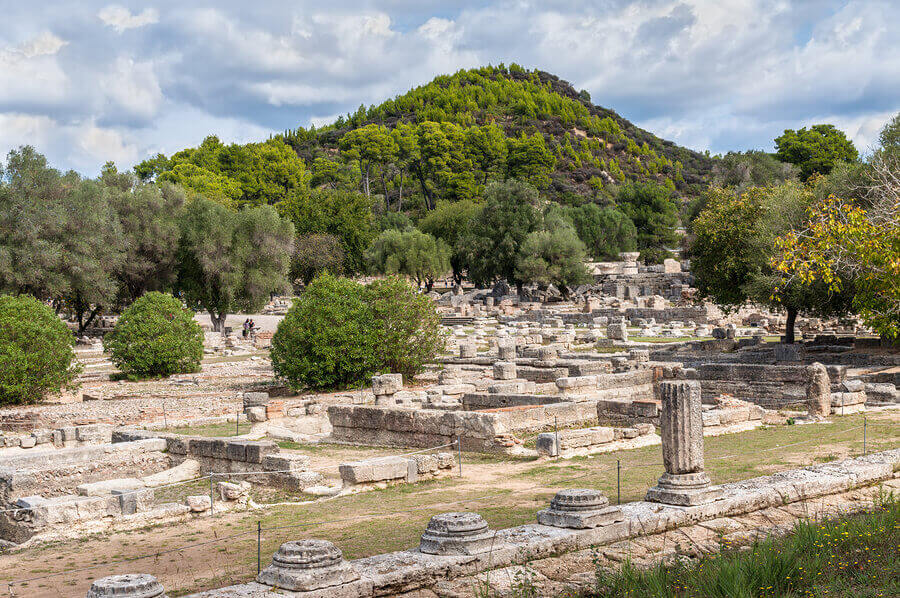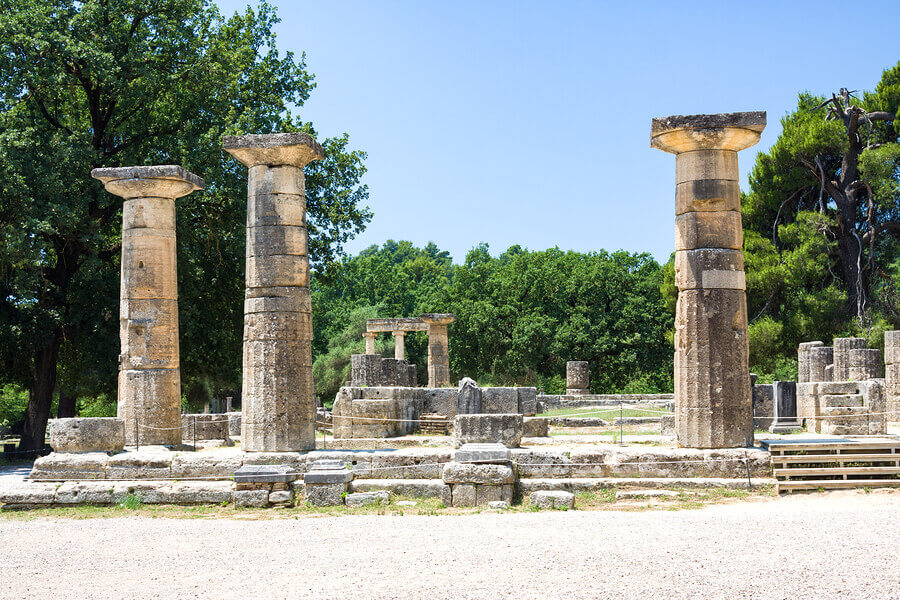A Visit to the Ancient Site of Olympics: Olympia

Do you love following the Olympic Games? Isn’t amazing that they started thousands of years ago? In our post today we want to take a trip to Olympia, Greece where the Olympics first began.
Olympia, the site of the first Olympic Games
Olympia sits at the foot of Mount Kronio, close to the Alpheus River. Holding one of the four ancient Olympic Games, the city honored Zeus. The Games took place every four years between June and July since 776 BC. The Ancient Games events included wrestling, chariot racing, javelin and discus throwing.
However, in 393 Emperor Theodosius halted the Ancient Olympic Games. Consequently, the buildings and installations were abandoned and many crumbled into ruins.
At the end of the 19th century, Baron Pierre de Coubertin reintroduced the Olympic Games and organized the first edition in 1896 in Athens. At the Stadium of Olympia, the Olympic relay torch is kindled symbolically by the rays of the sun, which reflect a parabolic mirror. The torch then begins its journey across the world.
In 1989, officials declared the archaeological site of Olympia a World Heritage Site because of the great historical value of its ruins.
Getting there and things to see
You can reach Olympia from Athens or from other areas of the country by driving. There are two main routes that are especially scenic and popular with tourists: Corinth-Patras-Pyrgos or Corinth-Tripoli-Arcadia. You can also reach Olympia by bus.

In Olympia, you can feel the Olympic spirit at its fullest. In addition, you can also imagine the Ancient Games unfolding before you. Make sure you see:
1. Archaeological zone
Start off your tour by diving into the history of Olympia. Visit the Stadium of Olympia, gymnasium ruins where the participants signed up— who were all men by the way– Pheidias’ workshop, accommodations (Leonidaion) and the Temple of Zeus.
The Temple of Zeus might very well be the most iconic symbol of Olympia. We know today that the temple housed an enormous statue of Zeus, which was destroyed in a fire. Only a single column of what once was the temple stands today.
You can access the Stadium of Olympia– which you can see in the featured image– by walking under the main arch. The judges’ seats and starting lines still remain today. And you can pretend to run a race as if you were a true Ancient Olympian!
Lastly, the Archaeological zone also includes the Temple of Hera, which remains in good condition. The beautiful Doric, circular temple stands next to the Nymphaeum.
2. Archaeological Museum of Olympia
The Archaeological Museum is another must-see in Olympia. The museum displays different pieces that were collected by excavation teams over the years. Some of the pieces include parts of the Temple of Zeus.
3. Museum of the Ancient Games
Not everyone makes a stop here but don’t miss it if you want to continue learning about the Ancient Olympic Games. Take a walk through the rooms and discover mosaics and paintings in addition to archaeological ruins from competitions. The museum also has a great collection of statues.

Helpful information before visiting Olympia: the summer hours are from 8:00 am to 8:00 pm while the winter hours are from 8:00 am to 5:00 pm. The admission fee is 12 euros per person (cash only). Most people spend two to three hours here, which is plenty of time to walk around the ruins and take pictures. If you plan on visiting the museum, plan for an additional hour.
Keep in mind that shade is scarce and there aren’t many places where you can buy drinking water. Lastly, remember to act respectfully, refraining from touching or passing into restricted areas as it’s an archaeological site.
Do you love following the Olympic Games? Isn’t amazing that they started thousands of years ago? In our post today we want to take a trip to Olympia, Greece where the Olympics first began.
Olympia, the site of the first Olympic Games
Olympia sits at the foot of Mount Kronio, close to the Alpheus River. Holding one of the four ancient Olympic Games, the city honored Zeus. The Games took place every four years between June and July since 776 BC. The Ancient Games events included wrestling, chariot racing, javelin and discus throwing.
However, in 393 Emperor Theodosius halted the Ancient Olympic Games. Consequently, the buildings and installations were abandoned and many crumbled into ruins.
At the end of the 19th century, Baron Pierre de Coubertin reintroduced the Olympic Games and organized the first edition in 1896 in Athens. At the Stadium of Olympia, the Olympic relay torch is kindled symbolically by the rays of the sun, which reflect a parabolic mirror. The torch then begins its journey across the world.
In 1989, officials declared the archaeological site of Olympia a World Heritage Site because of the great historical value of its ruins.
Getting there and things to see
You can reach Olympia from Athens or from other areas of the country by driving. There are two main routes that are especially scenic and popular with tourists: Corinth-Patras-Pyrgos or Corinth-Tripoli-Arcadia. You can also reach Olympia by bus.

In Olympia, you can feel the Olympic spirit at its fullest. In addition, you can also imagine the Ancient Games unfolding before you. Make sure you see:
1. Archaeological zone
Start off your tour by diving into the history of Olympia. Visit the Stadium of Olympia, gymnasium ruins where the participants signed up— who were all men by the way– Pheidias’ workshop, accommodations (Leonidaion) and the Temple of Zeus.
The Temple of Zeus might very well be the most iconic symbol of Olympia. We know today that the temple housed an enormous statue of Zeus, which was destroyed in a fire. Only a single column of what once was the temple stands today.
You can access the Stadium of Olympia– which you can see in the featured image– by walking under the main arch. The judges’ seats and starting lines still remain today. And you can pretend to run a race as if you were a true Ancient Olympian!
Lastly, the Archaeological zone also includes the Temple of Hera, which remains in good condition. The beautiful Doric, circular temple stands next to the Nymphaeum.
2. Archaeological Museum of Olympia
The Archaeological Museum is another must-see in Olympia. The museum displays different pieces that were collected by excavation teams over the years. Some of the pieces include parts of the Temple of Zeus.
3. Museum of the Ancient Games
Not everyone makes a stop here but don’t miss it if you want to continue learning about the Ancient Olympic Games. Take a walk through the rooms and discover mosaics and paintings in addition to archaeological ruins from competitions. The museum also has a great collection of statues.

Helpful information before visiting Olympia: the summer hours are from 8:00 am to 8:00 pm while the winter hours are from 8:00 am to 5:00 pm. The admission fee is 12 euros per person (cash only). Most people spend two to three hours here, which is plenty of time to walk around the ruins and take pictures. If you plan on visiting the museum, plan for an additional hour.
Keep in mind that shade is scarce and there aren’t many places where you can buy drinking water. Lastly, remember to act respectfully, refraining from touching or passing into restricted areas as it’s an archaeological site.
All cited sources were thoroughly reviewed by our team to ensure their quality, reliability, currency, and validity. The bibliography of this article was considered reliable and of academic or scientific accuracy.
- Javier Martín Sánchez. La ciudad y el templo de Zeus en Olimpia. Historia de la Grecia Clásica. https://www.academia.edu/36134037/LA_CIUDAD_Y_EL_TEMPLO_DE_ZEUS_EN_OLIMPIA
- Correo del Orinoco. Antorcha olímpica iniciará recorrido hacia Tokio en marzo 2020. Noviembre de 2019. http://www.correodelorinoco.gob.ve/antorcha-olimpica-iniciara-recorrido-hacia-tokio-en-marzo-2020/
This text is provided for informational purposes only and does not replace consultation with a professional. If in doubt, consult your specialist.








